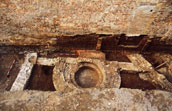
Archaeological Site
The Rotunda Church
 Inside the southern section of the Pieve of Palazzo Pignano, dating back to the 11th century (in other words 1000 years ago), you can see the remains of the Rotunda Church that was built at the end of the 5th century (1600 years ago), and which today stands destroyed and partly buried under the present day Church.
Inside the southern section of the Pieve of Palazzo Pignano, dating back to the 11th century (in other words 1000 years ago), you can see the remains of the Rotunda Church that was built at the end of the 5th century (1600 years ago), and which today stands destroyed and partly buried under the present day Church.
The old Church was circular in shape, with an apse on the eastern side, and a porticoed façade towards the west. Besides housing the altar, the apse also had a seat made of cocciopesto where the priest would sit. Pieces of the original flooring remain: the centre was laid with hexagons in black marble and mosaic triangles with white mosaics. This kind of floor is called opus sectile, while the outside section was paved with white, red and black geometric mosaic. A baptismal font was also found in one of the rooms of the Rotunda, and this can now be seen outside the Pieve.
What was the purpose of such a rich Church in such an isolated location like Palazzo Pignano? We know that Saint Ambrose, the Bishop of Milan during the 4th century (when the Christians were no longer being persecuted), had insisted that wealthy landowners become more involved in spreading Christianity in the rural areas and on their farms, where the majority of people were still pagans. The Rotunda Church at Palazzo Pignano was the oldest church in the Crema area. The first Christians were baptized there almost 1600 years ago.
The shape selected for the old church at Palazzo Pignano is quite unusual, and was rarely used and then only for churches that housed specific relics or the tombs of saints. The most famous Rotunda Church is the Church of the Holy Sepulcher in Jerusalem, also known as the Anastasis.










